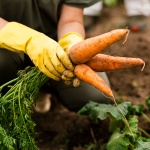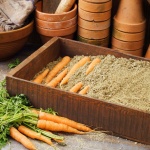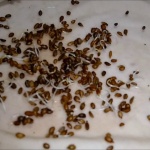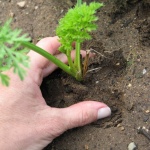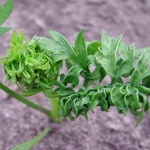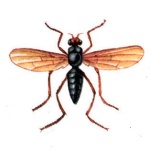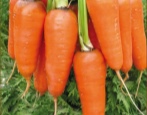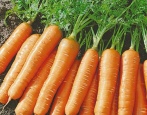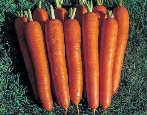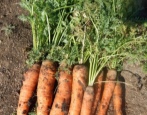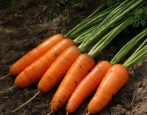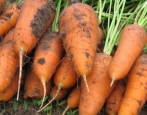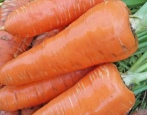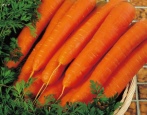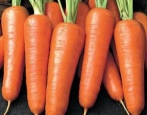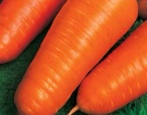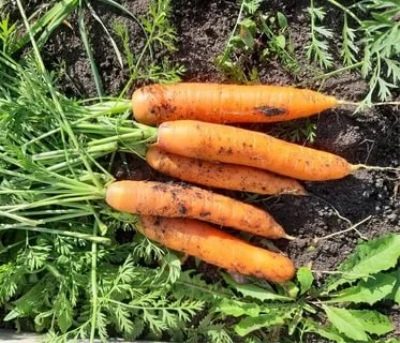
- Authors: Syngenta, Holland
- Name synonyms: Dordogne
- Year of approval: 2007
- Appointment: for fresh consumption, for canning, for freezing, for bundled products, for making juice
- Leaf rosette shape: upright
- Leaves: medium to long, dark green, finely split
- Weight, g: 80-128
- The form : cylindrical with blunt tip
- Taste qualities: good and excellent
- Composition : dry matter 12.0%, total sugar 7.1%, carotene up to 12.1 mg per 100 g of raw matter
Dordogne carrots are considered one of the most popular varieties, which attracts gardeners with high yields and large fruits. The culture is suitable for cultivation in many regions of the country, has a strong immunity.
Breeding history
Breeders from Holland were engaged in breeding Dordogne. For the first time, the variety was obtained in 2004, and already in 2007, after successfully passed tests, the carrots were included in the state register.
Description of the variety
Dordogne carrots should be classified as a medium-ripening plant. Carrot leaves are formed into an upright rosette and have a rich dark green hue. The plant is quite powerful, capable of forming a large root crop and delighting with a rich harvest.
Characteristics of the appearance of the plant and root crops
The Dordogne is considered one of the most attractive varieties. Among the features of carrot root crops:
- uniform structure in the phase of full maturity;
- predominantly cylindrical with a blunt tip;
- the core is orange;
- length 18-20 cm;
- weight reaching 80-128 g.
The maximum diameter of carrots reaches 6 cm. The upper part is resistant to greening, so the roots can always boast a rich orange hue.
Purpose and taste of tubers
Tasters rate the taste of the Dordogne as juicy and sweet. The root vegetable contains a large amount of nutrients, among which sugars and carotene should be singled out separately. The variety is suitable for fresh consumption, as well as for preparing first and second courses, salads. Finally, carrots are used for freezing and preservation.
The main plus of the variety is that the fruits do not lose their taste and marketability within 10 months. Therefore, Dordogne carrots are able to withstand long distance transportation.
Maturation
For the formation of root crops, the variety takes from 115 to 120 days, subject to the necessary agrotechnical recommendations. In warmer regions, carrots can be harvested after 70 days.
Yield
The maximum yield indicator reaches 6 kg per square meter. At the same time, gardeners note that the quality and quantity of the harvest practically does not depend on external factors in the form of weather conditions. It is interesting that one hectare is capable of producing up to 527 centners of root crops.
Growing regions
Dordogne carrots are grown in many districts and regions of the country. The variety is especially common in the following regions:
- North;
- Northwest;
- Central.
Less commonly, carrots are found in the West Siberian and Volga-Vyatka regions. Recently, they began to grow the variety in the North Caucasus.
Growing and caring
First of all, it is worth noting that the location for growing Dordogne carrots should be changed every three years. Otherwise, the immunity of the culture will decrease every year, which will lead to the development of various diseases and attacks of pests.
The advantage of the Dordogne is its unpretentiousness to growing conditions. The variety can be planted on almost any soil. But to get a bountiful harvest, it is worth considering a few recommendations:
- the soil must be fertile and loose;
- when choosing a place, it is worth stopping at sunny and calm areas;
- before planting carrots, you need to fertilize the soil.
It is better to dig up the beds in the fall in order to ensure the rapid survival of seeds in the spring. Landing at the same time does not require much effort. All you need to do is re-dig up the soil, make rows and plant the seeds.
Gardeners begin planting work closer to mid-April in the southern regions and by the end of May in the northern ones. It is important that the soil has time to warm up to 8 degrees Celsius in order to prevent the death of the plant from frost. Landing scheme:
- between the rows you should retreat up to 5-7 cm;
- between seeds - up to 15 cm;
- planting depth - 1-2 cm.
After that, it remains to take care of the plant. The main recommendations will be as follows.
- Watering. Carrots are undemanding to watering, so the need to add moisture should be monitored by soil moisture. If the soil is dry, water the plant.
- Top dressing. The plant must be fertilized during the period of growth and active formation of root crops. Usually gardeners use nitrogen-containing formulations, among which saltpeter or superphosphate is popular.
- Loosening and weeding. After each watering, it is important to remove weeds from the garden bed that can bring pests or diseases with them.
Additionally, it is worth taking care of regular thinning of the beds in order to ensure comfortable formation of root crops and achieve high yields.
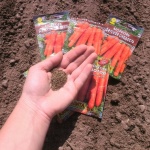
Carrots are one of the most unpretentious crops in terms of growing conditions; they can endure a short drought and a short cold snap. However, to get tasty and large root crops, you should adhere to the basic rules for planting carrots.
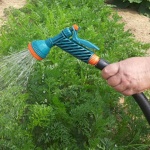
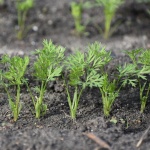
Disease and pest resistance
The Dordogne has a fairly strong immunity. The plant is not susceptible to common diseases and can withstand attacks from pests. However, gardeners recommend carrying out preventive treatments of the crop with special, weakly concentrated formulations.

Carrots grow in almost any garden. There is an opinion that this culture is very resistant to all kinds of diseases and pests, but this is not the case. Without proper care, carrots become susceptible to all kinds of infections and are affected by harmful insects.
Review overview
According to gardeners, among the advantages of Dordogne carrots are:
- resistance to most diseases and pests;
- beautiful roots;
- excellent indicators of transportability;
- high content of nutritional components;
- ease of packing and packaging.
The latter is achieved due to the short length of the root crops. The variety speaks positively, which is why carrots are so popular in many regions.
